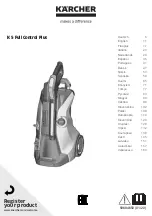
9
English
• Never fill fuel tank completely. Fill tank to 12.7 mm
below bottom of filler neck to provide space for fuel
expansion. Wipe any fuel spillage from engine and
equipment before starting engine.
• DO NOT let hoses come in contact with very hot
engine muffler during or immediately after use of your
pressure washer. Damage to hoses from contact with
hot engine surfaces will NOT be covered by warranty.
NOTICE:
NEVER pull water supply or high pressure hose
to move pressure washer. This could damage hose and/or
pump inlet/outlet.
• DO NOT use hot water, use cold water only.
• Never turn water supply off while pressure washer
engine is running or damage to pump will result.
• DO NOT stop spraying water for more than two
minutes at a time. Pump operates in bypass mode
when spray gun trigger is not pressed. When the
temperature inside the pump rises too high the
thermal relief valve (
16
, Fig. F) will open and release
a gush of water in an effort to lower the temperature
inside the pump. The thermal relief valve will then
close. If pump is left in bypass mode for more than
two minutes internal components of the pump can
be damaged.
Prior to starting, refer to your engine manual for
proper starting procedure.
1. In a well-ventilated outdoor area, add fresh, high-quality,
unleaded petrol with a pump octane rating of 86 or
higher. Do not overfill. Wipe up spilled fuel before starting
the engine. Refer to engine instruction manual for
correct procedure.
IMPORTANT: Ethanol Shield™ (sold separately) is a fuel
stabilizer that helps eliminate and prevent ethanol related
problems in power equipment. Follow the instructions on
the container and add to the petrol.
NOTICE:
Use of fuels with greater than 10% ethanol are
not approved for use in this product per EPA regulations
and will damage the unit and void the warranty.
2. Check engine oil level. See
Engine Owner’s Manual
for
correct procedure.
3. Connect the water hose to the water source. Turn the water
source on to remove all air from the hose. When a steady
stream of water is present, turn the water source off.
4. Verify the filter screen
13
is in water inlet of pump.
nOTE:
Convex side faces out.
5. Connect water source
14
to pump inlet
10
.
nOTE:
Water
source must provide a minimum of 38 liters per minute at
20 psi.
6. Connect high pressure hose
3
to pump outlet
9
.
WARNING: To reduce the possibility of
contamination always protect against backflow
when connected to a potable water system.
7. Choose the correct nozzle for the job to be performed. See
how
To Use spray Wand
instructions in this section.
nOTE:
If
applying a chemical or cleaning solution, see
how To Apply
Chemicals/Cleaning solvents
instructions in this section.
8. Turn water source on.
NOTICE:
Risk of property damage. Failure to do so could
cause damage to the pump.
9. Remove all air from the pump and high pressure hose by
depressing trigger until a steady stream of water is present.
10. Start engine. See
Engine Owner’s Manual
for
correct procedure.
WARNING: Risk of unsafe operation. If engine does
not start after two pulls, squeeze trigger of gun to
relieve pump pressure. Pull starter cord slowly until
resistance is felt. Then pull cord rapidly to avoid
kickback and prevent hand or arm injury.
11. Depress trigger on gun to start water flow.
WARNING: Risk of unsafe operation. Stand on a
stable surface and grip gun/spray wand firmly with
both hands. Expect the gun to kick when triggered.
12. Release trigger to stop water flow.
WARNING:
Do not allow the unit to run for more
than two minutes without the gun trigger being
pulled. This could cause overheating and damage to
the pump. When the temperature inside the pump
rises too high, the thermal relief valve will open and
release a spray of water from the pump to lower the
internal temperature. The valve will then close.
WARNING:
Risk of injury from spray. Always engage the
trigger lock
15
when gun is not in use. Failure to do so
could cause accidental spraying.
Shutting Down
1. After each use, if you have applied chemicals, place
detergent siphon hose into container of clean water and
draw clean water through chemical injection system to rinse
system thoroughly.
NOTICE:
Risk of property damage. Failure to do so could
cause damage to the pump.
2. Turn engine off. See
Engine Owner’s Manual
.
NOTICE:
Risk of property damage. NEVER turn the water
off with the engine running.
3. Turn water source off.
4. Pull trigger on spray gun to relieve any water pressure in
hose or spray gun.
nOTE:
Failure to release system pressure will prevent removal of
high pressure hose from spray gun or pump connection.
5. See
Storage
section in this manual for proper
storage procedures.
Summary of Contents for DXPW3200V
Page 1: ...DXPW3200V ...
Page 2: ...B Copyright DeWALT English original instructions 3 ...
Page 3: ...1 Fig A 3200 3200 1 2 3 4 5 7 8 9 10 11 Fig B Fig C 3200 7 8 17 4 5 Fig D 12 11 ...
Page 4: ...2 Fig E Fig F Fig H 4 3 16 Fig G Fig I Fig K Fig L 11 5 13 Fig J 14 10 3 15 11 14 9 11 ...
Page 16: ...DXPW3200V revA 09 20 AUST 1800 841 749 NZ 0800 467 813 ...


































